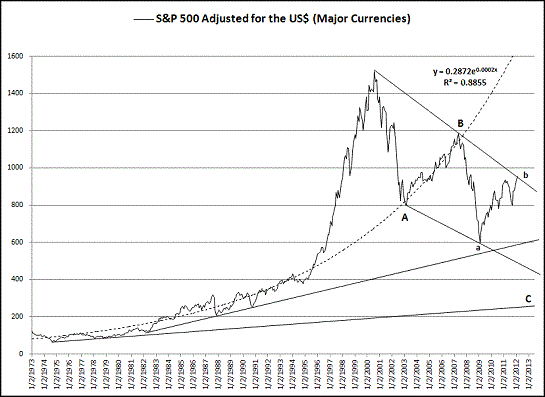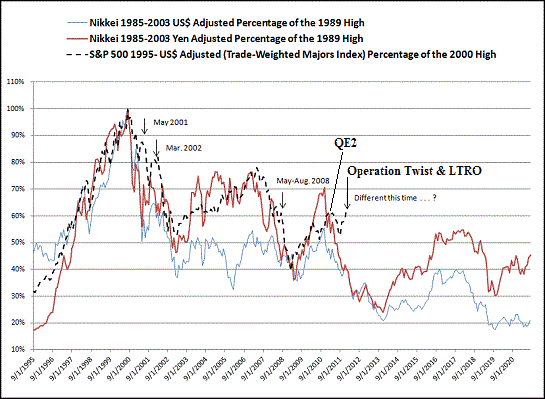If this rally runs out of steam, history suggests the next move down could plumb depths not seen in years.
If the market rolls over here, the next bottom might be a lot lower than most players think possible. After all, the "news" is all positive: Europe's debt crisis is now resolved; employment in the U.S. is trending up, GDP is growing nicely, etc. etc. etc.
As food for thought, here are two charts, courtesy of frequent contributor B.C., that suggest the good news might not only be priced in, but it might abruptly cease flowing.
The first chart is of the S&P 500 from 1973 to the present. The current rally has stalled right at a multi-year line of resistance, and a potential A-B-C pattern in a long-term channel suggests a return visit to the March '08 lows around 666, or perhaps even lower.
Here are B.C.'s observations:
If a C wave is imminent, a typical pattern is 2 (or 2.382-2.764) x A or a target of the '02-'03 and fall '08 lows, or even as low as the 500s-600s eventually. C = A would imply an idealized target in the 460s and nominal SPX 600s (US$ constant at the current level).
Such a decline in a period of "growth" seems impossible, but we should keep in mind the possibility that four conditions could cause growth to roll over and corporate profits to compress:
1. Rising energy input costs
2. Rising U.S. dollar decimates overseas earnings of U.S. corporations
3. Tapped-out consumers run out of gas (literally)
4. Federal government stops borrowing and blowing 10% of GDP every year
Next up, an analog chart of the Nikkei and the S&P 500 (SPX). To align apples to apples, this chart tracks the dollar-adjusted Nikkei from its top in 1989 and the dollar-adjusted SPX from its top in 2000. (For reference, the yen-adjusted Nikkei is also plotted.)
Interestingly, the SPX has tracked the Nikkei rather closely--at least until the extraordinary monetary interventions by the Federal Reserve known as QE2 and Operation Twist put booster rockets on the market (with some recent aid from the ECB's LTRO injection of about $1.5 trillion into the banking sector since December).
If the SPX were to continue tracking the Nikkei, the next bottom won't occur until late 2013 or early 2014--two years hence.
Here are B.C.'s notes on this chart:
Note how relatively closely the SPX was tracking the currency-adj. corollary with the Nikkei until QE2 and "Operation Twist". Coincidence . . .? I suspect not. Had the SPX tracked the corollary as in '01 and '08, the SPX would be in the 800s-900s by now.Can the Fed and shadow banksters prevent for the next 18-24 months the historical tendency for the SPX to follow the self-similar cyclical and secular patterns? I suspect we are going to witness their ongoing desperate attempts to do so.
The problem for the Fed is that interest rates are already zero, and playing around with bonds and buying more mortgages (the Fed already owns $1 trillion) is ultimately pushing on a string: the Fed can't force all the free money into productive investments, nor can it force banks to lend or consumers to spend.
The cliche is "don't fight the Fed;" there is no need to "fight the Fed" because they're busy self-destructing, and all we have to do is watch.
Maybe the market will follow Apple in a trajectory to the moon here. If it doesn't, a variety of other models suggests the wheels may fall off the "growth and rising profits forever" story and the market will decline to test recent lows or even hit new lows.
That's not what the Fed or the politicos want, but events on stage may be slipping beyond their off-stage control.
| Thank you, James M. ($60), for your astoundingly generous contribution to this site -- I am greatly honored by your support and readership. | | Thank you, Alfred V. ($50), for your exceptionally generous contribution to this site -- I am greatly honored by your support and readership. |





























